
|
|
Model Glow-Plug Heat Ratings
This careless approach to the selection of the right plug can often extend to the thread length. Plugs come with a variety of threaded lengths to suit a range of installation thread lengths in the cylinder heads of different engines. The most common error is the use of a short-reach plug in a head threaded for a long-reach component. Apart from burying the element deep in a recess in the head where it is less accessible to the fuel mixture, this has a far greater effect than many people realize in terms of reducing the engine's working compression ratio. There's really no excuse for getting this wrong, but I'm always encountering engines having the wrong-length plug fitted. In this article, however, we are primarily concerned with one of the least well-understood variables in the operation of model glow-plug engines. This is the question of glow-plug heat rating. Indeed, the mode of operation of the glow-plug engine is something of a clouded issue. And there’s no more clouded issue than the matter of ignition timing in a glow-plug engine. The full theory behind glowplug ignition is extremely complex and seemingly rather superficially understood by many glow-plug users. Most people recognize the role of the glow-plug at its most simplistic level as being the provision of a “hot spot” in the combustion chamber at which the combined temperature of the compressed fuel mixture and the glowing plug element is sufficient to initiate ignition of the mixture. That's about as far as it goes for many folks. In a very general sense, this understanding is basically correct. However, there’s far more to it than that! Consideration of the effective use of this form of ignition must take account of the interplay between such factors as compression ratio, variations in the upper and lower explosive limits of the fuel, caloric value of the fuel, oil content in the fuel, cylinder head temperature, atmospheric conditions, gas flow through the engine, combustion chamber configuration, flame propagation efficiency, the role of catalysis between the fuel and the platinum plug element (which is far more significant than many people realize) and finally plug heat rating (the main topic of this article). Really, when you think about it, with all these variables kicking around, it’s highly unlikely that the average glow-plug engine is operating in the field at its absolute best. Indeed, I sometimes think that the wonder is not that glow-plug ignition works so well but that it works at all! But it does work, and the purpose of this article is to help you to do what you can to maximise performance through the selection of the best glow-plug to use in your particular engine and application. Plug selection is one of the above criteria over which you do have some control – use it!! The Importance of Ignition Timing Ignition timing refers to the point in the engine’s operating cycle at which the ignition of the fuel mixture in the combustion chamber is initiated. Like any other internal combustion engine, a model glow-plug unit delivers its best performance when the ignition timing is optimized for the speed at which the engine is being operated.
If ignition is initiated too early (a condition called pre-ignition), the early build-up of gas pressure will resist the piston’s mechanically-enforced completion of the upward compression stroke. Quite apart from robbing the engine of power, this will impose extra stress upon its working components, since they have to force the piston over top dead centre against the premature build-up of combustion pressure. Taken to extremes, this can actually lead to structural failure of the engine's working components. Pre-ignition also potentially leads to overheating or even detonation, the latter being a very harmful condition in which the fuel mixture explodes all at once rather than burning progressively. This generates potentially significant shock loadings upon the working components. Rather like detonating a small hand grenade in the combustion chamber! If ignition is initiated too late (retarded ignition), the resulting pressure build-up will never reach its potential maximum, again robbing the engine of power. However, retarded ignition won’t harm the engine. When considering the issue of ignition timing in a glow-plug engine, the first fundamental point to keep in mind is that once a glow-plug having a given heat rating is installed in a specific engine and the fuel to be used has been selected, the operator has no further control over the ignition timing of the engine when leaned out to the optimum mixture for most efficient combustion on that fuel. Moreover, the ignition timing resulting from a particular combination of engine, plug and fuel will only be absolutely correct (optimized) in a fully leaned-out engine over a relatively narrow speed range. In general, below that range the engine will tend to be in pre-ignition mode when leaned out, while above it the ignition timing will generally be later than ideal. In either case, some form of ignition timing adjustment is required. Anyone who has spent time running diesel or spark ignition engines will readily grasp this point from their own experience. The settings of the compression screw (which controls ignition timing in a diesel) or the timer on a sparker will vary considerably with engine speed. In general, the higher the speed, the higher the compression setting (and hence the earlier the ignition) for best performance with a diesel. Similarly, the higher the speed of a sparker, the more advanced the timer has to be set for best results. A glow-plug engine is no different – after all, it’s just an internal combustion engine like the others, the sole functional difference being the means of ignition. Its ideal ignition timing will also become more advanced as speeds climb and retarded as the speed drops. Moreover, since different engines peak at widely varying speeds, the optimum ignition timing at the power peak will vary considerably from engine to engine. The problem with glow-plug ignition is that, unlike with a diesel or sparker, the operator has no direct control over the ignition timing once the engine is running.
Accordingly, it must be understood that the needle valve actually controls not one but two operating parameters – the combustion characteristics of the mixture and the ignition timing. The challenge is to find a plug having a heat range that allows the optimization of both parameters simultaneously for a given applied load. It should be clear from the above discussion that for a given engine fitted with a specific plug, bringing the ignition timing to the optimal setting for the particular load and fuel being used may require compromises in fuel mixture setting, since that is the only means at the operator’s disposal for changing the plug element temperature and hence the timing once the engine is running. However, even if the optimum timing is achieved for a given combination of engine, plug, fuel and load, that timing will only be appropriate over a relatively narrow speed range, as stated earlier. Changing the load, and hence engine speed, will shift the optimum ignition timing one way or the other, requiring some form of adjustment in response. It should be obvious that if the achievement of the optimum ignition timing requires a richer than ideal mixture, power output will inevitably be compromised due to reduced combustion efficiency. Far better to use a different variable - plug heat range - to allow simultaneous optimization of both the mixture strength and the ignition timing for the intended operating speed. That's the central thesis of this article!
If we have an engine/plug/fuel combination that results in optimal leaned-out ignition timing at the engine’s peaking speed, all will be well as long as we operate at or near that speed using that plug and fuel. However, if we then load the engine down to a significantly lower speed by using a larger prop, all bets are off and the leaned-out ignition timing will now be too far advanced – the potentially harmful condition referred to earlier as pre-ignition. One of the things that has always amazed me as a model engine historian is how long it took for the model engine testers of the early glow-plug era from 1948 onwards to grasp the fact that any glow-plug engine operating on a given plug and fuel will only be properly timed over a relatively narrow speed range when fully leaned out, as discussed above. One of the worst offenders in this respect was Lawrence H. Sparey of “Aeromodeller” magazine. He clearly failed to grasp the previously-demonstrated fact that leaned-out glow-plug ignition timing will only be optimized within relatively narrow engine speed limits depending upon a combination of compression ratio, combustion chamber configuration, fuel mixture composition and plug heat range. He assumed instead that a glow-plug engine is in effect self-timing over a wide range of speeds - an incorrect assumption, as we shall see.
Try setting your diesel compression screw or spark ignition timer for the correct timing at 13,500 rpm and then loading the engine down to run leaned out below 5,000 rpm without reducing compression or retarding the timer......... that in effect is what Sparey was doing, seemingly without realizing it. It’s certainly a testament to the Yulon’s mechanical integrity that his test example apparently survived such treatment! The ETA 29 was not so fortunate ........... see Sparey's test of that model which appeared in the September 1949 issue of "Aeromodeller".
The truth which Sparey (and others) failed to grasp is that for any given combination of plug and fuel there will be a relatively narrow “sweet spot” at which the engine’s speed and its leaned-out ignition timing will be perfectly matched. Go either side of that, and perfection will be at an end! Another critical point to recognize is that the engine speed at which the leaned-out timing is optimized on any particular combination of fuel and plug may or may not correspond to its potential power peak. To maximize peak output, we want to create a situation in which the engine can be operated at its peak with both the fuel mixture strength and the ignition timing optimized. This in turn means selecting the correct plug and then choosing a load (usually an airscrew) that actually allows that peak speed to be developed in flight. But surely, you say, Sparey was right to believe that the glow-plug engine is self-timing – as speeds rise, the plug should glow hotter and advance the timing, right? Well, to a point that’s true …… but only to a point. Glow-plug ignition is actually at least as much dependent upon a catalytic reaction between the methanol in the fuel and the platinum in the glow-plug element as it is upon the combustion-induced element temperature alone.
This catalytic reaction between the plug element and the incoming fresh mixture heats the platinum, replacing any heat lost by cooling between firing strokes. Consequently, differing levels of combustion heating don’t have nearly as much effect upon element temperature and hence ignition timing as might be supposed – the catalytic reaction plays a very significant role, considerably dampening the effect of combustion heating alone. Most critically, the plug doesn’t cool down at lower speeds anywhere near as much as it would if the catalytic reaction were not involved. Hence the slower speed doesn’t retard the timing nearly as much as might be anticipated. The role of the catalytic reaction is the major factor which Sparey and his colleagues failed to appreciate. Since there's no oscillation or rapid gas movement going on to create a dynamic situation when the engine is at rest, initiation of this catalytic reaction requires that a certain element temperature be achieved by other means. This is why the plug has to be electrically lit for starting. However, once the engine starts and the catalytic reaction is initiated, the reaction becomes self-sustaining and will continue at some level more or less regardless of the thermal input from the combustion process. This is why R/C glow-plug engines continue to run at very low throttle openings, why four-stroke engines run just fine even at idling speeds with half the number of combustion heating opportunities and why un-throttled engines continue to run on very rich mixtures, in all cases with the plug receiving minimal heat from fuel combustion. It’s the catalytic reaction that keeps them going under such conditions - indeed, without that reaction glow-plug engines probably wouldn't idle at all. All of this having been said, a higher combustion-induced element temperature will certainly advance the ignition timing to some degree. The question then becomes - how much advance is desirable? Our goal should be to arrange for a sustainable plug element temperature that provides the optimum ignition timing for the speed and mixture strength at which we want to run the engine, which may or may not be its peaking speed or on a leaned-out mixture setting, depending on the application. We do this by matching the heat rating of the plug to the other parameters (engine, fuel, load, needle setting, ambient air conditions). Glow-Plug Heat Ratings In simplistic terms, the heat rating of a glow-plug is a reflection of the amount of combustion-generated heat required to maintain the plug element at its optimum operating temperature. A “cold” plug will require more combustion-generated heat to maintain that temperature than a “hot” plug. Put another way, a “hot” glow-plug sustains its temperature more effectively between successive firing strokes, whereas a “cold” plug cools down more rapidly between successive strokes. It’s helpful to have some understanding of the physical attributes of hot and cold glow-plugs. There are no hard-and-fast rules – the particular platinum alloy from which the element is made doubtless has some bearing on the matter. However, in general the following two parameters will combine to set a given plug’s heat rating: Element thickness – the diameter of the wire used to form the element coil in the plug. Obviously, the effect of using thicker wire will be to increase the surface area, mass (weight) and linear conductivity (along the wire) of the element. The greater surface area and linear conductivity combine to increase the rate at which heat is either radiated or conducted away from the element surface between firing strokes. The increased mass means that more thermal input is required to replace any lost heat. The net result is that a thicker element will tend to operate at a lower temperature than a thinner one. Therefore, a characteristic of colder plugs is that they usually have elements which are wound from thicker wire than their hotter counterparts. Cavity diameter – the inside diameter of the cavity within the plug body in which the element is located. That cavity is formed within the threaded section of the plug body, which is of course in intimate contact with the installation thread in the cylinder head. Consequently, its inner wall will be maintained at or very near the engine’s cylinder head temperature, which will be far below that of the element. The proximity to theelement of this relatively cool surface can have a substantial effect upon the cooling of the element between firing strokes - The two plugs seen in the accompanying image demonstrate these differences well. The one on the left has a large-diameter cavity with a relatively thin-wire element, while that on the right has a small cavity with a thick-wire element. In relative terms, the left-hand plug is clearly hotter than the right-hand plug. This information can be helpful when assessing a plug for which you have no heat rating data – many old “classic” plugs fall into this category. In very general terms (and there are exceptions), a plug having a relatively thin-wire element and/or a relatively large cavity surrounding the element may be expected to be a hotter plug than one having thicker wire and/or a smaller cavity. Operational Implications of Plug Heat Rating It should now be clear that we can significantly influence the ignition timing in a glow-plug engine by using plugs having different thermal characteristics, or heat ratings. Our goal should be to find a plug which will operate at a sustained element temperature which yields the correct ignition timing for the conditions under which the engine will be run in service. It turns out that there are a number of factors which will have a strong influence upon this choice.
Obviously, the higher the compression ratio, the higher the mixture temperature as the piston approaches the ignition point near top dead centre. Too high a glow-plug element temperature under those conditions could lead to pre-ignition. A somewhat colder plug may therefore be an appropriate choice for a high-compression engine. It seems worth mentioning in passing that the oil content of the fuel has an influence upon the engine's effective working compression ratio. A higher oil content has the effect of increasing the effective operating compression ratio to some degree, and vice versa. This is because the excess oil, most of which is (hopefully!) unburned, occupies space in the combustion chamber, thereby reducing its effective volume. The effect is not large, but it's there. It is in fact a very effective approach to fine-tuning a fixed compression diesel.
Conversely, if the engine is a low-compression model and/or will be run on a somewhat rich mixture (as with a classic control-line stunt motor, for example) a hot plug will be used to achieve a higher and hence more optimal element temperature than its cold alternative. I hope it’s now becoming clear that the temperature characteristics of different plugs can have a far greater effect upon engine performance than seems to be generally realized. Experience has shown that the use of a plug having the appropriate heat rating can yield as much as 2000 extra RPM over an incorrectly-chosen plug. In an R/C engine, the correct plug may also improve throttle response to a remarkable degree. Too cold a plug can cause loss of power due to excessively retarded ignition. In addition, throttle response in an R/C engine may well be less than optimal using such a plug. However, the use of a too-cold plug shouldn’t damage the engine. This is far from true if too hot a plug is used, especially at lower leaned-out speeds. In that case, power may also suffer, but now due to pre-ignition, which will also place undue stresses upon the engine as well as making it tend to overheat (the Sparey syndrome!). It can even lead to such undesirable consequences as detonation, which is definitely not good either for the engine or the plug! So getting the plug heat rating right isn’t merely a matter of performance optimisation – it’s also a longevity factor for both engine and plug. All too few people seem to appreciate that. One might think that these problems can be overcome simply by using the needle valve. Not necessarily so – let’s look at an example. We know that when the mixture is leaned out, the leaner mixture burns hotter, hence heating the plug element more effectively and advancing the ignition timing accordingly. Obviously, the development of maximum power will require that the ignition timing be optimised. However, if the plug is too hot, then although the plug element temperature and hence the ignition timing can certainly be optimised by appropriate use of the needle to bring the element temperature down, the mixture required to produce optimal timing will undoubtedly be richer than desirable for most efficient combustion and maximum power.
The other possibility is that the plug is too cold. In this case, even leaning the engine out all the way to obtain maximum combustion efficiency and hence maximum thermal input to the element will not raise the element temperature sufficiently to achieve optimal ignition timing - the ignition point will be somewhat retarded, and there's nothing that you can do about it. Again, you can't win! The trick then is to find a plug having a heat rating which will allow its element to maintain the temperature which provides the optimum ignition timing with the needle set for maximum power on the particular load being applied. For different engines using different fuels with varying loads, the optimum element temperature range can vary far more widely than many users may realize – one size most definitely does not fit all! Hence the very definite benefits arising from taking the trouble to identify a plug having a heat rating which is well matched to the particular engine, fuel and load. Fortunately, there are a number of reputable companies who supply dependable glow-plugs in a wide range of heat ratings. Two Another more widely-known company which offers a range of glow-plugs in different heat ratings is O.S. of Japan. Their glow-plug web-page includes a comprehensive table showing the characteristics of the various plugs that they offer. All of their products are readily available on line. Finally, there's the famous Japanese Enya company, which also offers plugs in a variety of heat ratings They too have a glow-plug web-page which provides information on their plugs as well as advising users about their plug recycling program. This is a commendable initiative on Enya's part because the goal is primarily to recycle the relatively scarce and hence costly platinum in the element. Once again, Enya's plugs are readily available worldwide on line. A visit to the linked websites of any of these companies (and there are doubtless others) will provide some very good guidance. All four cited companies list their plugs using their own comparative heat rating systems. Enya supplies plugs in four distinct heat ratings; Model Technics offers its FirePower plugs in six different heat ratings; O.S. cites seven different ratings; while TCA’s range covers no fewer than eight such ratings. These ratings are not directly comparable between the different plug brands – they simply provide an indication of the comparative heat ratings of each company’s own products relative to each other. Model Technics has carried this one step further by quoting a parameter called Standard Heat Rating (SHR). This denotes how hot the plug is on the Standard Heat Rating scale. Any plug can be rated on this scale, which should allow for the comparison of plugs from different manufacturers provided that they have established these figures for their plugs. The scale runs from 0 to 100, with 0 being excessively cold and 100 being excessively hot. Plugs generally lie somewhere between these two extremes. Glow-plug Evaluation
But how do you identify that plug for your particular engine? Well, the engine manufacturer may have a plug heat rating recommendation, which should serve as a good starting point. However, quite a few manufacturers (particularly during the “classic” era) did not include such recommendations. Moreover, one manufacturer’s “hot” plug may not match the heat rating of a “hot” plug from a different source. Hence the only sure-fire way to make that identification is by testing. This task is greatly complicated by the fact that so many variables can affect the optimal element temperature for perfect ignition timing. This forces you to make certain choices in advance of testing. You will of course have selected your engine, which will have a specific built-in compression ratio, combustion chamber shape and scavenging characteristics. You can change the compression ratio if you wish, but only before the fun starts. That fixes two of the key pre-test variables – engine and compression ratio. You will no doubt have a prop in mind that should be well matched to both engine and model. You’ll probably make that selection using published test figures for the engine in question, assuming that such figures are available. If this information is lacking, you’ll have to rely upon prior experience with that particular engine or others like it, or upon the advice of others with such experience. Never be afraid to ask – modellers with more experience are almost always glad to share their knowledge.
Of course, a prop that allows the engine to reach its peak RPM in the air won’t turn that fast on the bench – there will naturally be some airborne pickup when the model is moving. Accordingly, for the very best results you probably want to do your plug testing using a prop that allows the engine to reach its peak or at least near its anticipated airborne speed (more or less) on the bench. This probably means using a slightly lighter prop-load than the one you’ll be using for flying purposes. The one caveat to that general principle is the testing of an R/C engine’s low-speed throttling characteristics Since things will unload far less at low speeds, it’s probably best to use the intended flight prop when testing low-speed and mid-range throttle response. You’ll have to decide upon the fuel that you plan to use. A fuel with more nitro will burn hotter than one with less. Therefore, the fuel definitely affects ignition timing and hence the required plug heat rating. Your plug testing needs to be done using the fuel with which you intend to supply the engine when in flight service. Finally, you’ll need to acquire samples of each plug that you intend to test. This may seem a bit expensive, but you should only have to do it once – after the testing is done, you’ll know which plug works best and can purchase only that plug for the engine in question in the future. Moreover, you can use the same range of plugs to test other engines. The other plugs will almost certainly prove to be the right ones for some of those other engines. None will end up going to waste. You’re now ready to set your engine up on the bench and try the effect on performance of using plugs having different heat ratings. The most basic test is of course to find the plug that gives the highest leaned-out RPM and hence the most power on the high-speed test prop (the one slightly smaller than the intended flight prop). For single-speed operation, as in a free flight or control-line application, the fastest plug is obviously the one to use for flying. You may be quite surprised at the range of speeds on the same engine, prop and fuel that can result from trying plugs of varying heat ratings. As a general rule, you'll find that the optimum needle valve setting becomes slightly leaner with the colder plugs, for the reasons discussed earlier. Of course, there are other parameters that merit your attention. You’ll certainly want to evaluate the engine’s starting and general running qualities using each tested plug. For an R/C engine being tested on its flight prop, you’ll want to assess its lowest reliable idle speed, pick-up from idle (having allowed time for the engine to cool at idle), mid-range pick-up and the degree to which its main needle setting becomes more or less critical. There are no hard-and-fast rules on plug selection – each engine will have its own preference, which the testing should reveal. Highly tuned racing engines with high compression ratios and/or hot fuels will probably require a very cold or at least cool plug. High performance contest engines intended for uses other than all-out racing or where variable speed operation is anticipated in a racing environment may do better with a plug in the middle of the heat range, while sports engines and many old-time classics will generally require a plug at the hotter end of the scale. The one thing to avoid at all costs is detonation when trying hotter plugs. Quite apart from the potential damage that this condition can cause to the engine, it’s also very hard on plug elements, often causing them to fail. Setting the needle a little on the rich side can minimize this possibility, but it is always there – pay close attention! Detonation is indicated by a sharp “snapping” sound in the exhaust note. Remember also that changing any one of the key variables will require that the testing be repeated. A switch to a significantly higher-nitro fuel will generally require a colder plug. Similarly, if you elect to decrease the compression ratio, a hotter plug will generally be required.
I’m always amazed at how many people are quite happy to use a short-reach plug in an engine whose cylinder head is tapped for a long-reach component. You see them all the time both at the flying field and in engines obtained on eBay or at swap meets. This practise has several quite significant effects which can adversely impact performance. For one thing, the element will be shrouded by being located deep inside the plug recess as seen from the combustion chamber, which is bound to have a negative effect upon ignition efficiency since it limits the exposure of the element both to the fresh charge of fuel mixture and the combustion flame. However, a far more insidious consequence of using a short-reach plug in a long-reach head is its effect upon the engine’s compression ratio. I won’t go into mathematical detail here, but suffice it to say that the extent to which such a combination can reduce the engine’s effective compression ratio would surprise many people. This is due to the unfilled portion of the plug installation thread being added to the volume of the combustion chamber at top dead centre. As you can see from the image above at the left, the excess combustion chamber volume caused by such a mis-match can be considerable. Because of the smaller combustion chamber volumes involved, the smaller the displacement of the engine, the greater this effect generally turns out to be. In engines below 2.5 cc (0.15 cuin.) it can be a real performance killer. Always use a plug whose reach is matched to the engine! If the plug is too long, use an extra plug washer as a shim. A plug which protrudes to any great extent from its installation thread will run at too high a body temperature. Moreover, an element that is located too close to the piston crown can promote detonation. A problem which has become more prevalent in more recent years as engine performances have climbed is a certain tendency towards leakage through the seal between the centre electrode and the body. In racing engines in particular, the seal is actually as likely to blow as the element! This is an area of plug design which has been very carefully considered by companies such as those mentioned earlier which offer glow-plugs for high-performance engines. Overall, present-day plugs are a considerable step forward from those of yesteryear. Keep that old classic plug for display by all means, but use a modern plug for reliability and performance.
The idle bar is there to keep the glow plug from being extinguished when the engine is quickly throttled up after a period of idling. When the engine is idling, it has a tendency to pool some excess fuel in the crankcase. Consequently, when the engine is suddenly throttled up, that excess fuel joins the rush of mixture up the bypass and transfer passages into the combustion chamber, where it meets the unshielded plug element head-on. With an unshielded plug at idling temperature, that excess fuel has a tendency to smother the element, potentially stopping the engine. The idle bar helps to prevent the flow of excess fuel from hitting the element, thus keeping the element at a temperature at which the catalytic reaction betwen methanol and platinum can continue to do its work. Model Technics’ Plug Testing Model Technics has done us a great service by publishing a series of tests that they themselves have undertaken over the years using their own FirePower plugs having various heat ratings. I gather that they have now tested some 80 different engines using their plugs and comparing the performance with that obtained using plugs from other manufacturers. Of the 80-odd engines tested, around 60 were sports engines, most of which showed a significant increase in performance once the correct FirePower plug to optimise the ignition factors discussed above was determined through the testing. The company’s linked website presents data from 24 of these tests. Although there is a lot to be learned about the effects of different plug heat ratings from studying this information, it must be borne in mind that the tests were conducted over a 6 month period. Accordingly, factors such as outside temperature, humidity and wind speed varied greatly and would have influenced the results to a significant degree. This invites a paragraph on the effect of ambient atmospheric conditions on engine performance. Air that is at a lower atmospheric pressure has less oxygen per unit of volume than air at higher pressure. Similarly, since air expands with a rise in temperature, once again unconfined hotter air has less oxygen per unit of volume. Finally, elevated humidity reduces the oxygen content of a given volume of air since the water vapour displaces some of the oxygen. In all cases, the engine ingests less oxygen during each induction cycle. Consequently, it will tend to run rich unless the needle is leaned out somewhat. Even then, it won’t develop the power that it would at higher ambient pressure, lower temperatures and/or lesser humidity – less oxygen plus less fuel equals less power. Setting aside considerations of possible ambient atmospheric differences between tests, Model Techics’ tests were conducted with all six FirePower plugs. As a control, they also included a highly-rated plug that they call the PCP93. They have used this plug as a standard for many years. The FirePower plugs used in the tests had the following characteristics:
In each table of results to be presented below, the “clicks leaner” column refers to the main needle valve setting. In the tests, Model Technics did not use the needle valve of the test engine – instead, they substituted one of their own remote needle valves which were very carefully engineered to provide highly precise mixture control. Several different remote needle valves were used throughout the tests, so once again caution must be exercised when making direct comparisons. The starting point for the number of clicks was always set at "0", for the F7 (very hot) plug since this would invariably require the richest setting for optimum ignition timing for the reasons discussed earlier. The head temperature was measured by a probe in the cylinder head of the engine. This probe was installed in a hole which was drilled in each case to within 0.020" of the combustion chamber. The maximum RPM figure was measured after 15 minutes of running to ensure complete warming of the system. The figure recorded in the tables was the highest speed that could be maintained with a stable head temperature. In a number of the tests a higher speed could have been achieved, but only with an escalating head temperature which would have ended in severe overheating and all its attendant problems. All head temperatures are given in degrees Celcius. Care must also be taken in comparing the test engine results with similar engines which you may own because Model Technics’ test engines are often a mixture of parts from more than one example or model. They’re comparing plugs, not engines! In addition, it’s highly unlikely that any modeller will be using a duplicate of Model Technics’ test silencing system, which is twenty feet high! The favoured plug based on the testing is marked with an asterisk. Most often this was the plug that gave the highest RPM along with acceptable throttling. However, it’s important to remember that when throttling is more important than out-and-out speed, a plug that is slightly lower on maximum RPM but displays superior throttling might well be the better choice. An example of such a test is included here. Some of the other features illustrated in the results are fascinating in their own right. Adding more nitromethane to the fuel almost always generates more power, but a switch to a colder plug may well be required to gain maximum benefit. Altering the compression ratio may also enhance power output, but it may be necessary to match both the plug and the fuel to the new parameter. As stated at the outset, the full theory behind glowplug ignition is extremely complex and still not completely understood. It’s therefore fortunate that there’s no need to wear out your brain thinking about this very complex process. Just be thankful that it works in practise as well as it does and carry out the suggested testing to determine the best plug for your engine! Here’s a representative sample of the tests conducted by Model Technics, reproduced here with their kind permission. The rest of their data may be perused on their previously-linked web page.
These results clearly show that the test engine needed a very hot plug for best performance. Note that there’s a difference of 450 RPM across the range of plugs tested. This underscores the earlier comments about the performance gains that can be achieved through the selection of the most appropriate plug. As we’d expect, the colder plugs can accommodate a leaner needle setting.
For this test using the same engine, a little nitro was added to the fuel, with everything else being left alone. Note that this had quite a significant effect on the optimal plug heat rating. This underscores the point made earlier that the fuel used is a significant factor in the selection of the best plug to use. Note also that the added nitro only resulted in the engine gaining some 330 RPM on the same prop. Hardly worth it ………
By comparison with the Super Tigre 25, the Fox 25 BB was a far less powerful engine. However, it clearly needed a pretty cold plug to give its best. In terms of power, there’s little to choose between a cold and a cool plug, but the throttle response was judged to be better with the cool plug. You have to decide what’s more important – the absolute maximum power or the best throttling. In this case, the difference in power is so small that going for improved throttling with the cool plug would appear to be the best choice.
Once again, same engine and prop but a little added nitro. Note that the engine now preferred the very cold F2 plug for maximum power, once more demonstrating the very significant effect of fuel formulation upon the correct choice of plug. The Fox benefitted quite a bit from the added nitro, gaining some 420 RPM on this prop. However, throttling seems to have suffered a little from the change in fuel. I’d probably stay with the F4 plug to retain the excellent throttling, giving up the 170 extra RPM that could be obtained by using an F2.
Now we’re back to the straight fuel used in test no. 3, but the compression ratio has been lowered a little. Oddly enough, the engine now likes a very cold plug even on the straight fuel used in this test. Maximum speed is up by 100 RPM compared with the standard engine using the same straight fuel. Apart from the preference for a colder plug for maximum power, there’s relatively little change – throttling performance seems to have been unaffected. Again, I would choose to stay with the F4 plug if throttle performance was my key criterion – the extra 90 RPM with the F2 is really inconsequential. When time permits, I plan to conduct my own series of tests on these and other plugs. I'll add the results to this article at that time. Conclusion Choosing the right glow plug for your particular engine and application not only improves performance, but can also extend the life both of your engine and the glow-plug itself. I hope that the information set put above will assist you in making this very important choice. Here are a few final thoughts on ways in which you can protect your investment both in your engine and the plug:
I think that’s about all I can tell you about this rather arcane subject. Hopefully some of this information will prove useful at some point in time! If there's anything that you think should be added or changed, please get in touch! __________________________ Article © Adrian C. Duncan, Coquitlam, British Columbia, Canada First Published November 2017 |
||||
| |
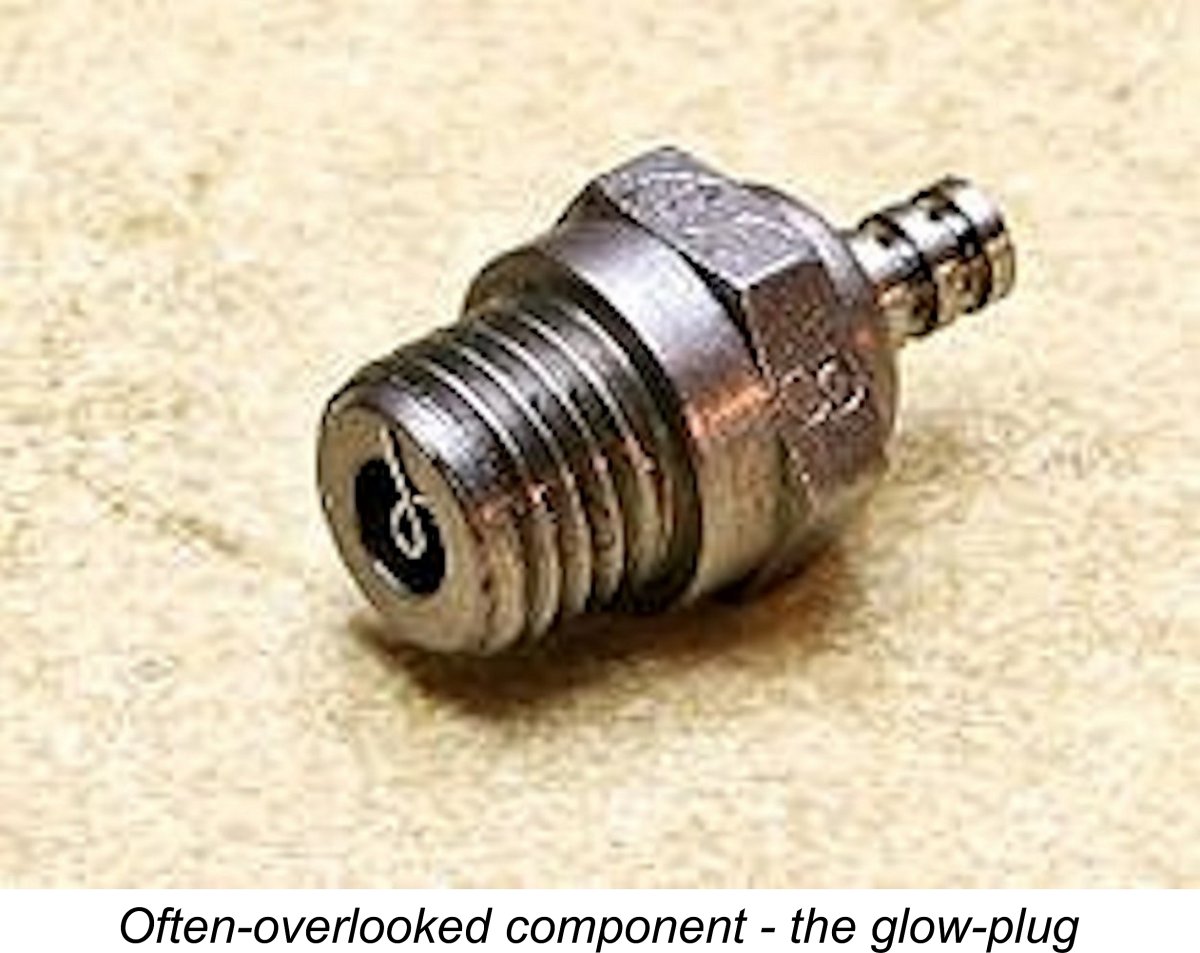 The component of any glow-plug engine which seems to be most often taken for granted is the humble glow-plug itself. Many people tend to fit whatever plug happens to be handy without worrying too much about whether or not it's the right one for their engine and application. This is unfortunate, because the careful selection of the best plug can have a dramatic effect upon both engine performance and longevity.
The component of any glow-plug engine which seems to be most often taken for granted is the humble glow-plug itself. Many people tend to fit whatever plug happens to be handy without worrying too much about whether or not it's the right one for their engine and application. This is unfortunate, because the careful selection of the best plug can have a dramatic effect upon both engine performance and longevity. 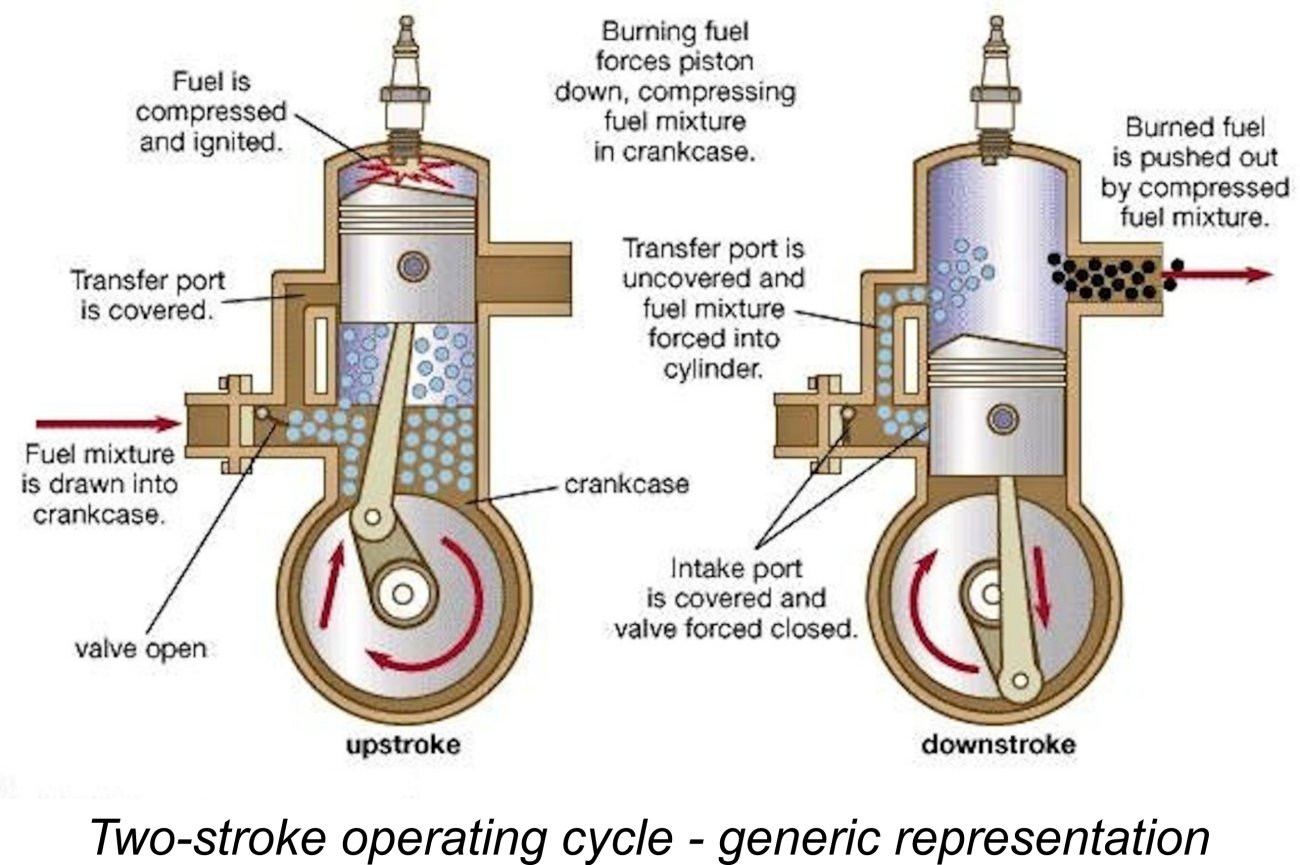
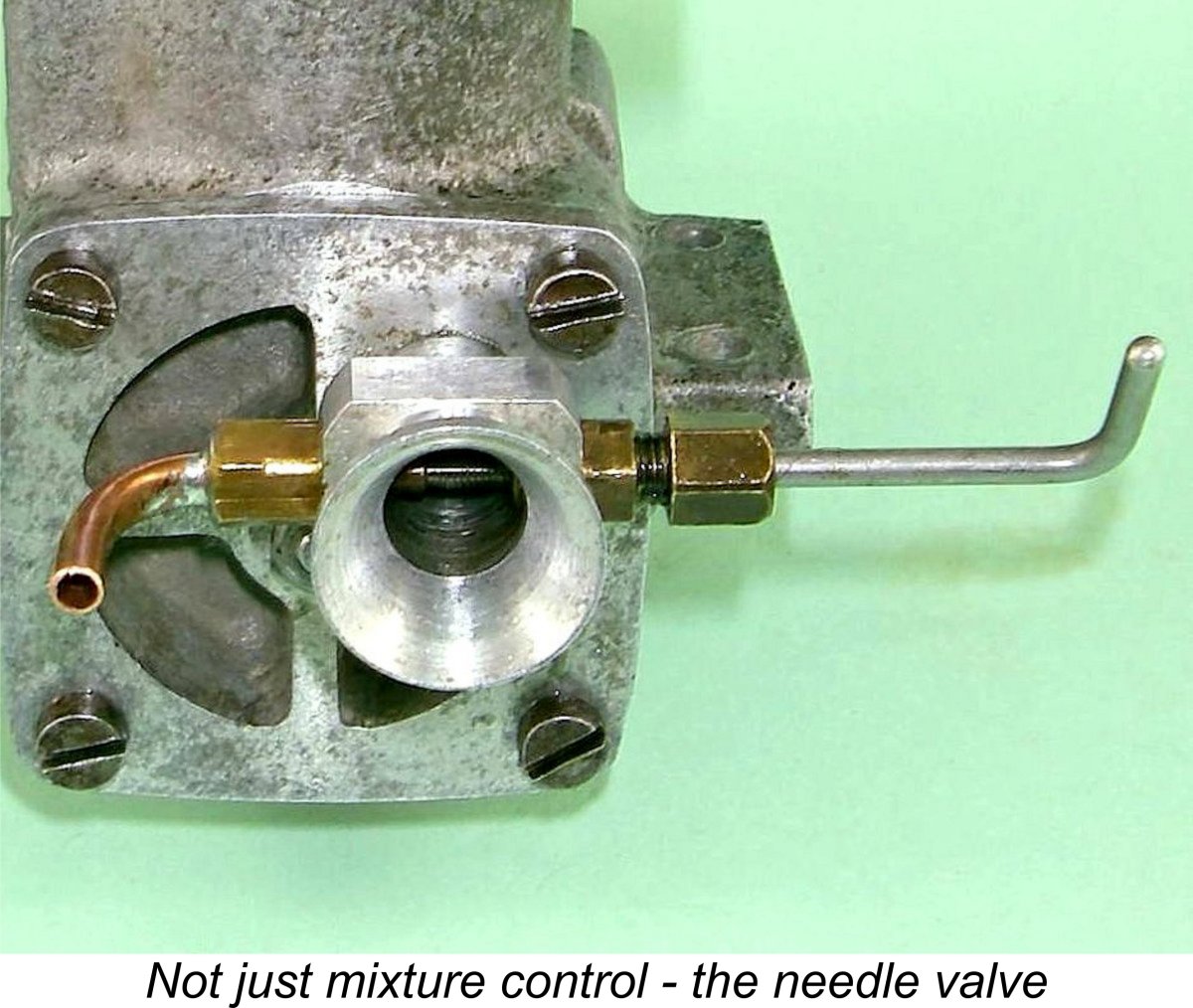 However, all is not lost! The operator does have an indirect means of adjusting the ignition timing of a glow-plug engine once it's running. This is the indirect control provided by the needle valve. Few people seem to realize that changing the mixture strength doesn’t just produce changes in combustion characteristics and hence power output – it also changes the ignition timing. A leaner mixture burns hotter, hence producing a higher plug element temperature which tends to advance the ignition timing. By contrast, a rich mixture burns cooler, reducing the element temperature and hence retarding the ignition timing.
However, all is not lost! The operator does have an indirect means of adjusting the ignition timing of a glow-plug engine once it's running. This is the indirect control provided by the needle valve. Few people seem to realize that changing the mixture strength doesn’t just produce changes in combustion characteristics and hence power output – it also changes the ignition timing. A leaner mixture burns hotter, hence producing a higher plug element temperature which tends to advance the ignition timing. By contrast, a rich mixture burns cooler, reducing the element temperature and hence retarding the ignition timing.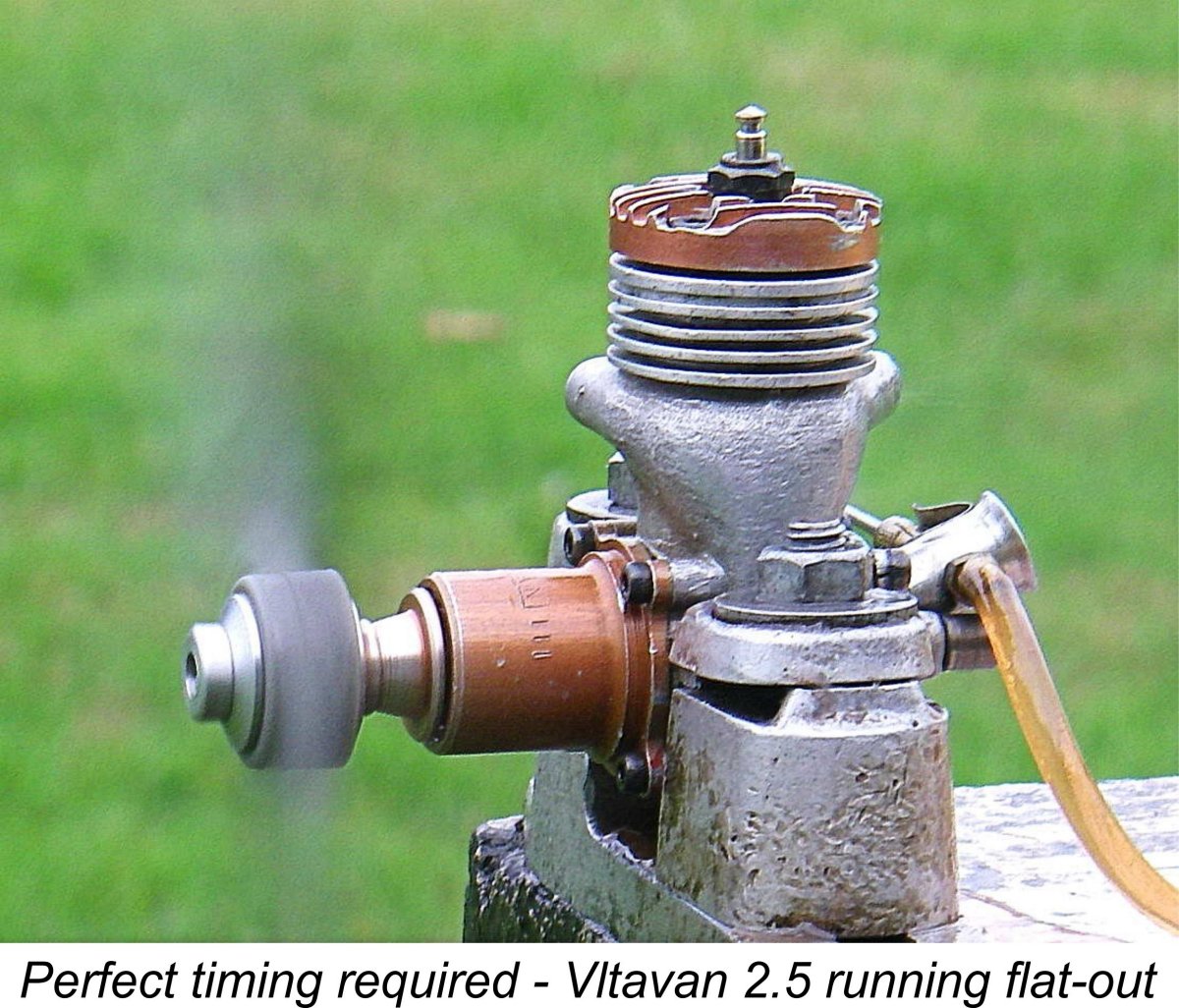
 This led to Sparey testing a number of glow-plug engines which had the misfortune to come his way at speeds which were clearly way below those for which their ignition timing was optimized. A notable example was Sparey’s November 1949 test of the
This led to Sparey testing a number of glow-plug engines which had the misfortune to come his way at speeds which were clearly way below those for which their ignition timing was optimized. A notable example was Sparey’s November 1949 test of the 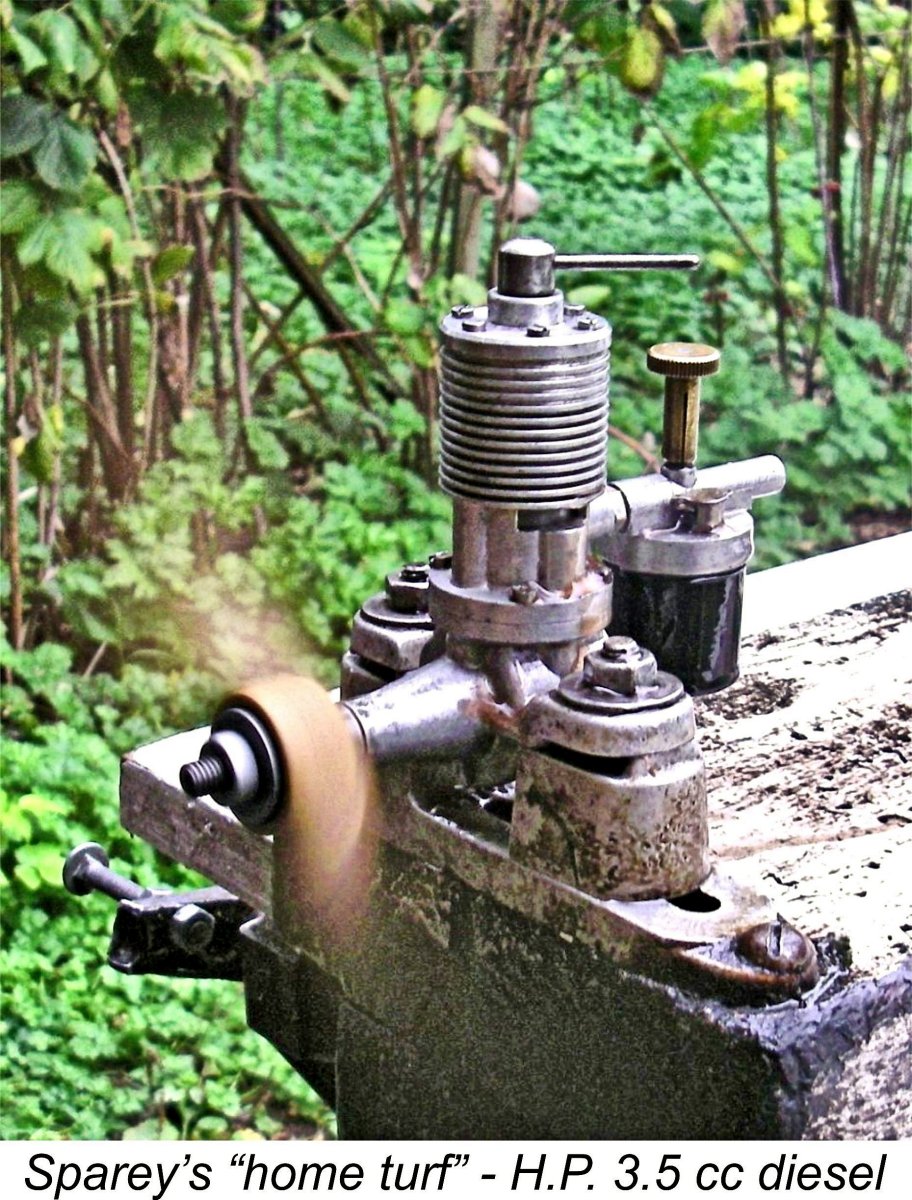 It was of course Sparey's prior experience with diesel operation which led him into this error. He was accustomed to testing long-stroke diesel engines which delivered masses of low-speed torque, hence being able to swing very large props effectively. He failed to realize that it was only the diesel's infinitely adjustable ignition timing via the compression control that allowed for this kind of performance.
It was of course Sparey's prior experience with diesel operation which led him into this error. He was accustomed to testing long-stroke diesel engines which delivered masses of low-speed torque, hence being able to swing very large props effectively. He failed to realize that it was only the diesel's infinitely adjustable ignition timing via the compression control that allowed for this kind of performance. 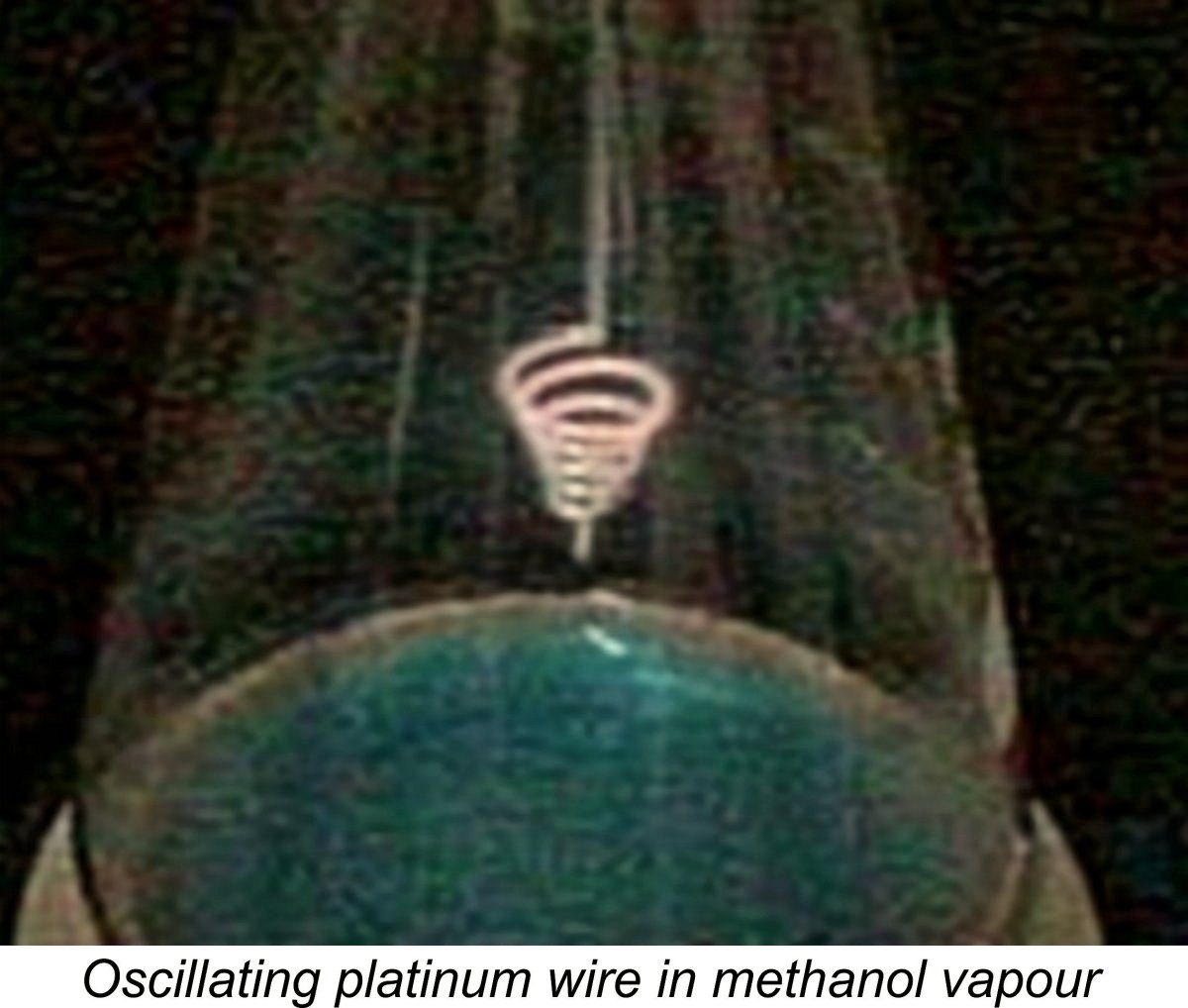 When the platinum in the element comes into dynamic contact with the methanol vapour in the fuel during the mixture transfer stage, the rapid movement of the gas and the oscillations of the element due to the combined effects of engine vibration and gas flow together promote the development of an exothermic (heat-producing) catalytic reaction between the two. This effect is far more powerful than generally realized - an unheated oscillating platinum wire coil which is suspended in a lab flask containing methanol and methanol vapour will quickly become incandescent, as the image at the left demonstrates.
When the platinum in the element comes into dynamic contact with the methanol vapour in the fuel during the mixture transfer stage, the rapid movement of the gas and the oscillations of the element due to the combined effects of engine vibration and gas flow together promote the development of an exothermic (heat-producing) catalytic reaction between the two. This effect is far more powerful than generally realized - an unheated oscillating platinum wire coil which is suspended in a lab flask containing methanol and methanol vapour will quickly become incandescent, as the image at the left demonstrates. 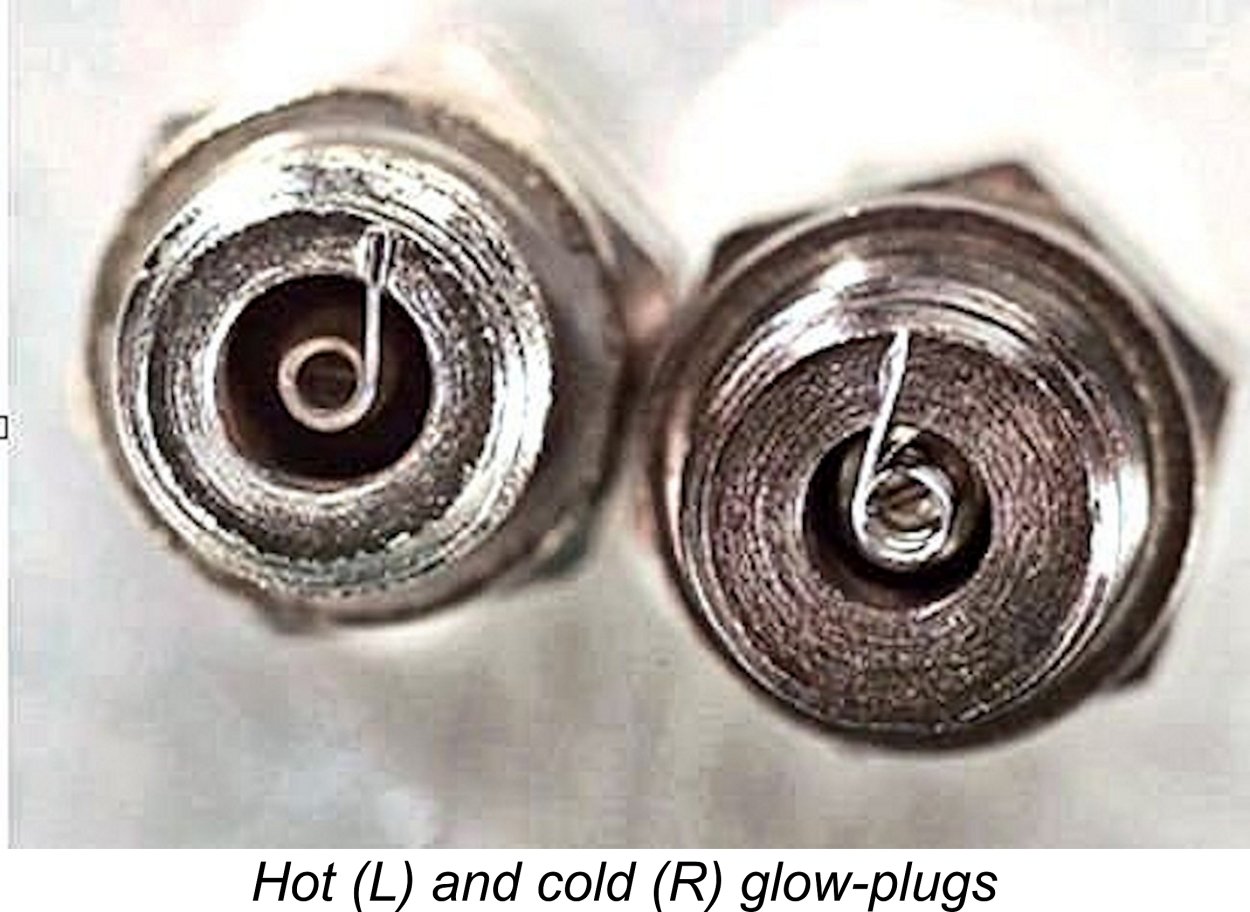
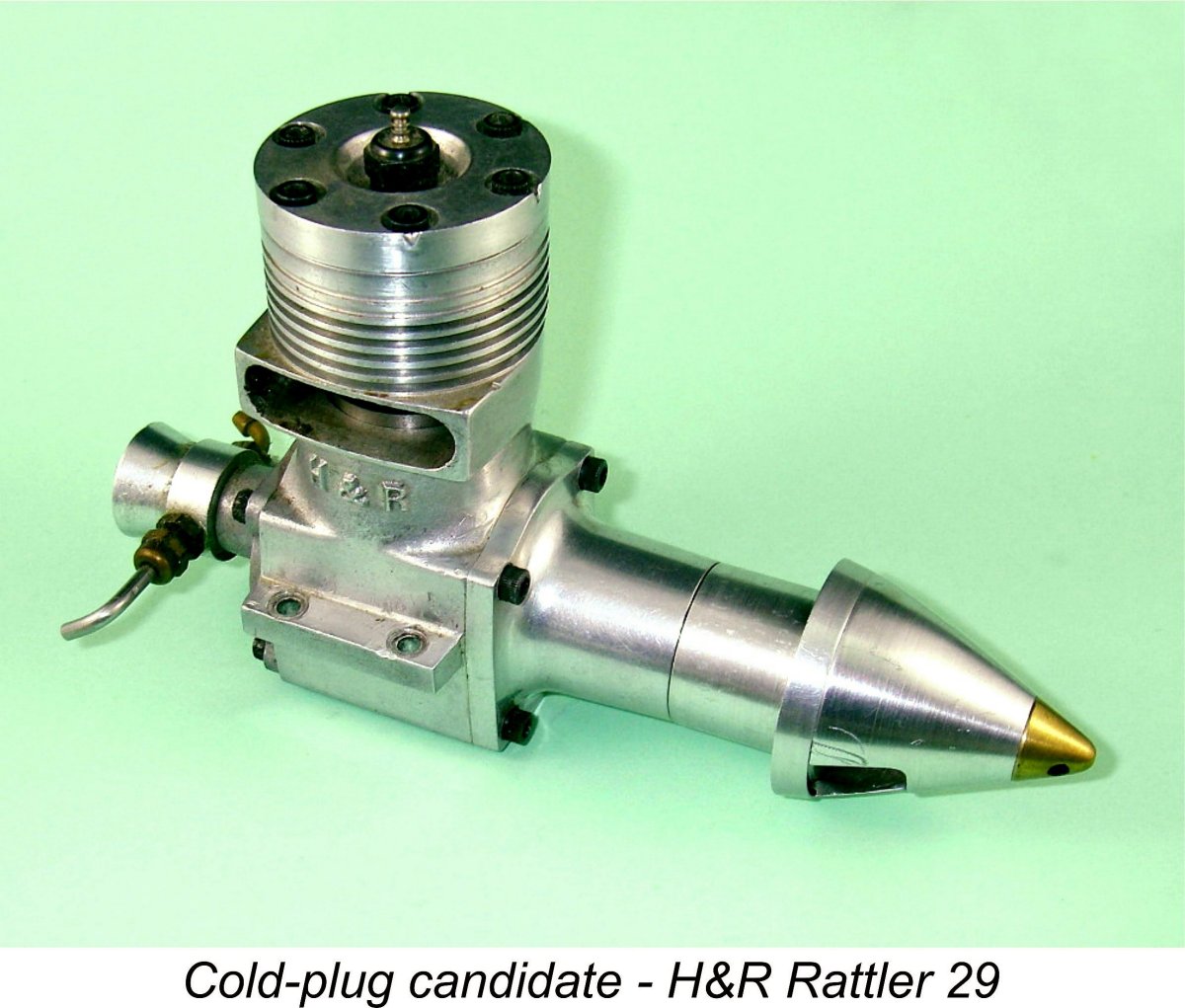 One of these factors is of course compression ratio, which will have a significant effect upon ignition timing in a glow-plug engine. The laws of physics tell us that when compressed, the temperature of a given quantity of confined gas will rise more or less in proportion to the degree to which it is compressed. Hence the compression of the fuel mixture in an engine’s cylinder by the rising piston has the desirable effect of pre-heating the mixture in advance of actual ignition by the plug (unless it’s a diesel, in which case the compression-generated heat is the ignition source!).
One of these factors is of course compression ratio, which will have a significant effect upon ignition timing in a glow-plug engine. The laws of physics tell us that when compressed, the temperature of a given quantity of confined gas will rise more or less in proportion to the degree to which it is compressed. Hence the compression of the fuel mixture in an engine’s cylinder by the rising piston has the desirable effect of pre-heating the mixture in advance of actual ignition by the plug (unless it’s a diesel, in which case the compression-generated heat is the ignition source!).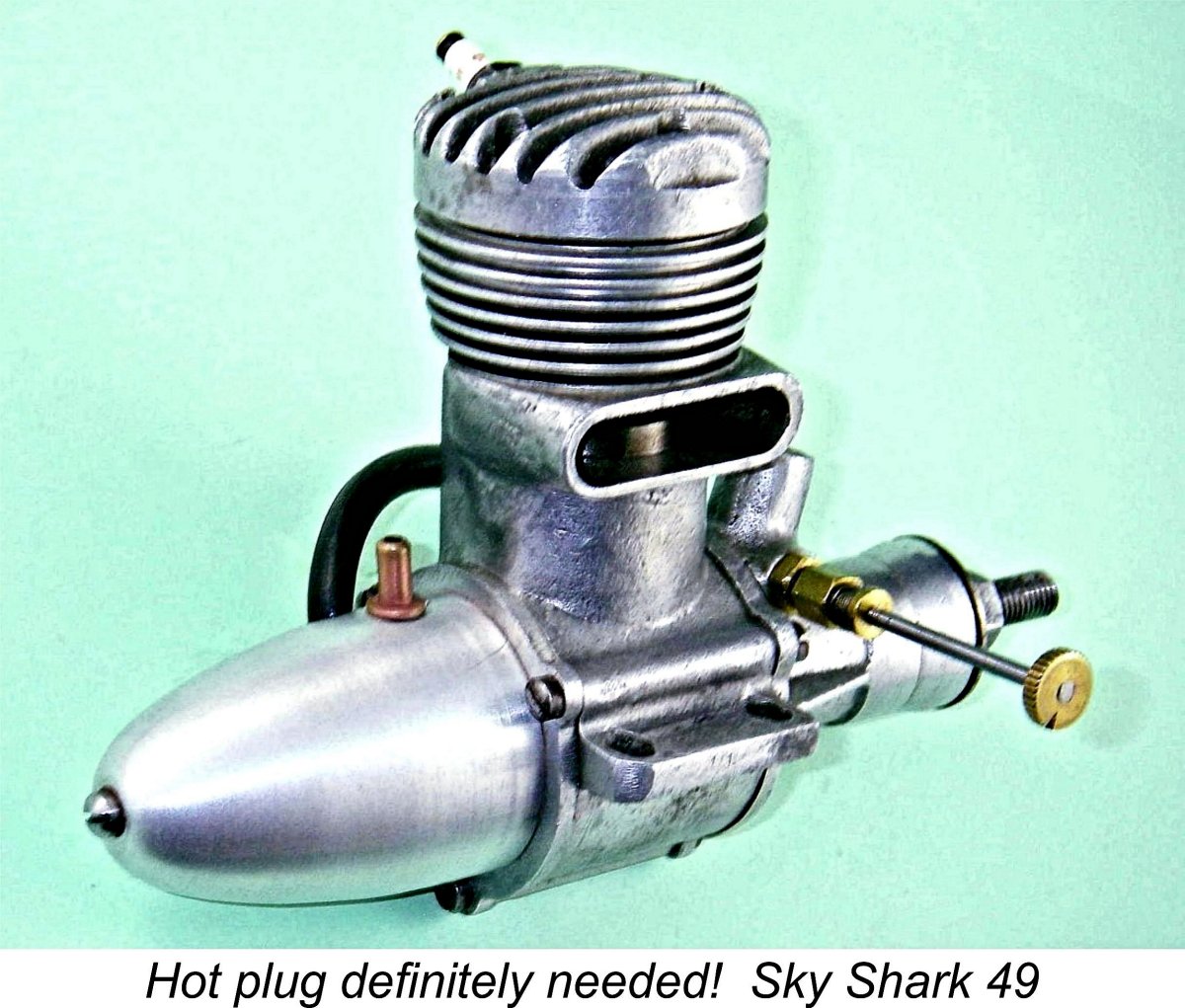 Since a lean mixture burns hotter than a rich one, a cold plug will likely require the heat generated by a leaned-out mixture to sustain its optimum operating temperature and hence give its best. Accordingly, if flat-out running on a lean mixture is intended, a cold plug is likely the correct choice, particularly if high speeds are anticipated or a high nitro fuel is used. A high compression ratio will also point towards a colder plug.
Since a lean mixture burns hotter than a rich one, a cold plug will likely require the heat generated by a leaned-out mixture to sustain its optimum operating temperature and hence give its best. Accordingly, if flat-out running on a lean mixture is intended, a cold plug is likely the correct choice, particularly if high speeds are anticipated or a high nitro fuel is used. A high compression ratio will also point towards a colder plug.  Obviously, you simply can’t win in this situation! You’re caught between a rock and a hard place – running at optimum mixture strength for efficient combustion will lead to pre-ignition, while richening the mixture to reduce plug element temperature to the ideal value for correct ignition timing will reduce combustion efficiency. Either way, you lose ……..
Obviously, you simply can’t win in this situation! You’re caught between a rock and a hard place – running at optimum mixture strength for efficient combustion will lead to pre-ignition, while richening the mixture to reduce plug element temperature to the ideal value for correct ignition timing will reduce combustion efficiency. Either way, you lose ……..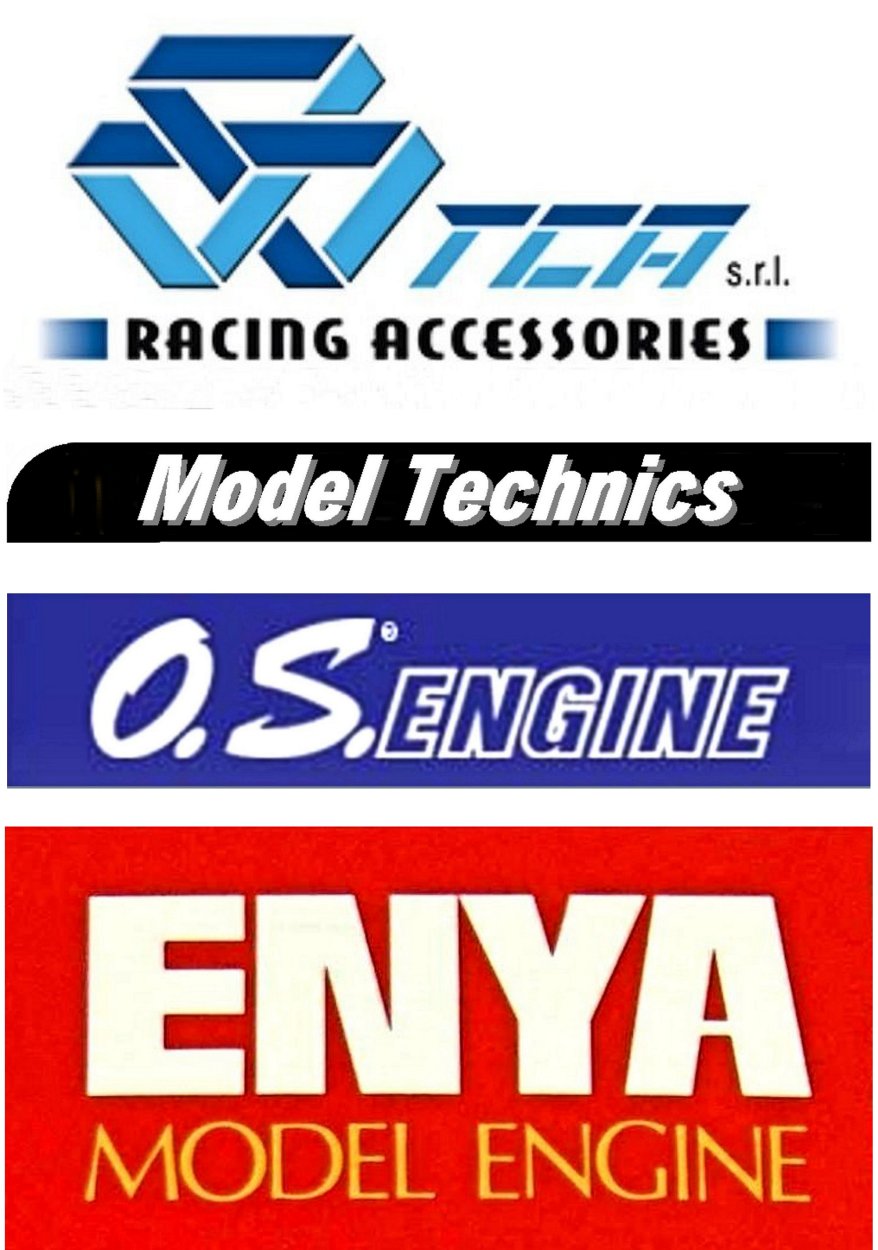
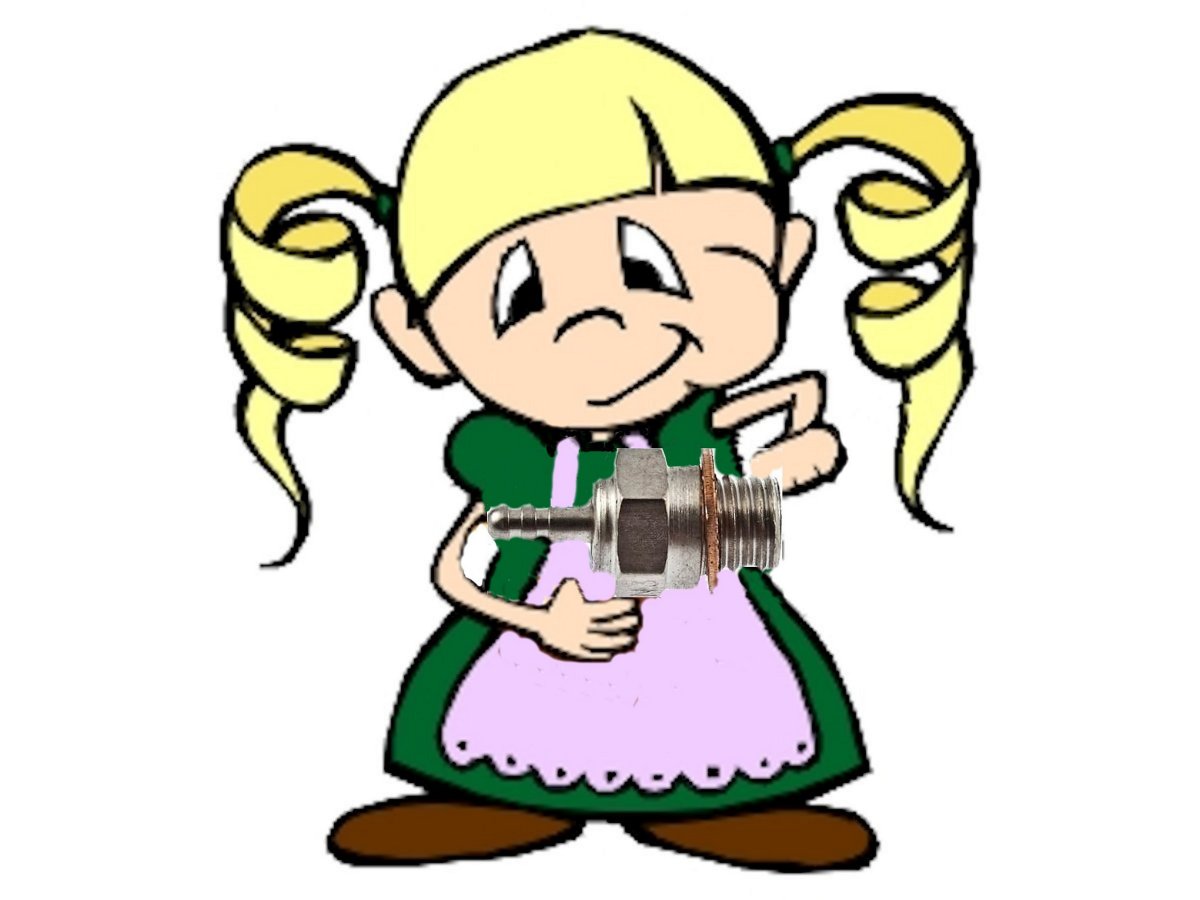 OK, fair enough – so there’s almost certainly a plug available that has just the right heat characteristics for your particular engine and application. Not too hot ….. not too cold ….. just right! The Goldilocks Plug, in fact!!
OK, fair enough – so there’s almost certainly a plug available that has just the right heat characteristics for your particular engine and application. Not too hot ….. not too cold ….. just right! The Goldilocks Plug, in fact!! 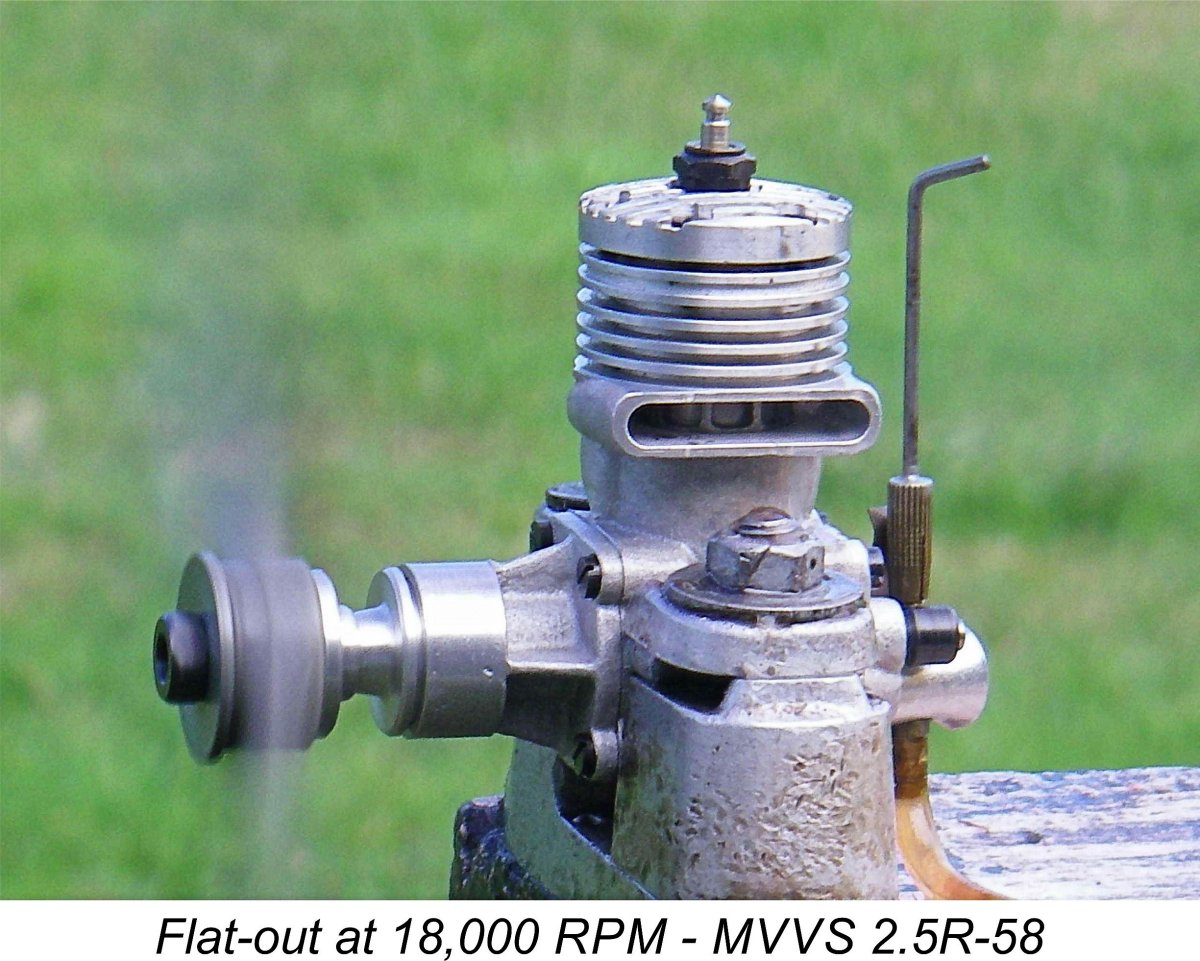 In many cases, the prop will be one that should allow the engine to operate at or near its peaking speed in the air. In other cases, you may wish to take advantage of the engine’s torque characteristics to spin a larger prop that will move more air even if the engine doesn’t reach its peaking speed in flight. It’s your choice ……..
In many cases, the prop will be one that should allow the engine to operate at or near its peaking speed in the air. In other cases, you may wish to take advantage of the engine’s torque characteristics to spin a larger prop that will move more air even if the engine doesn’t reach its peaking speed in flight. It’s your choice ……..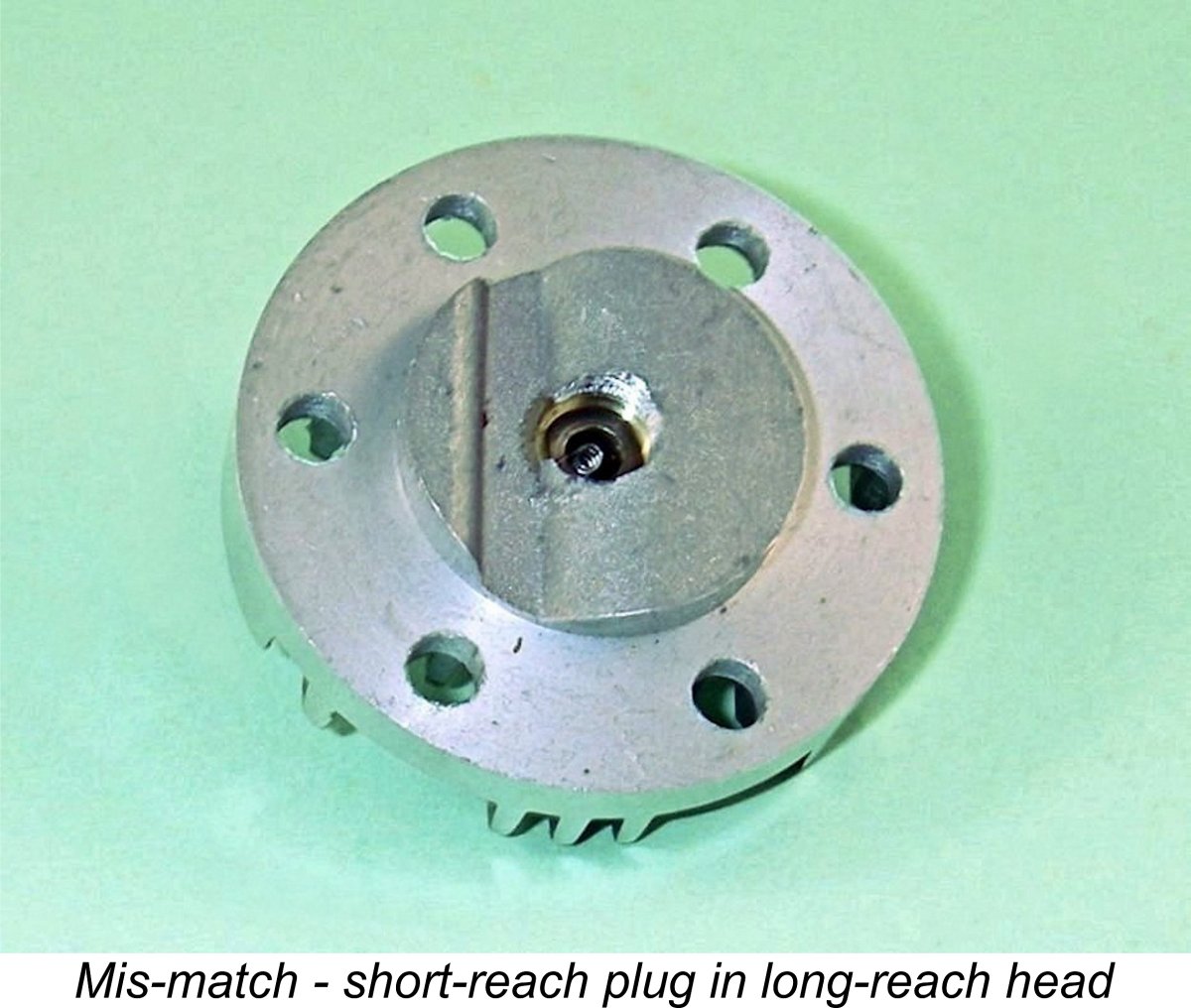
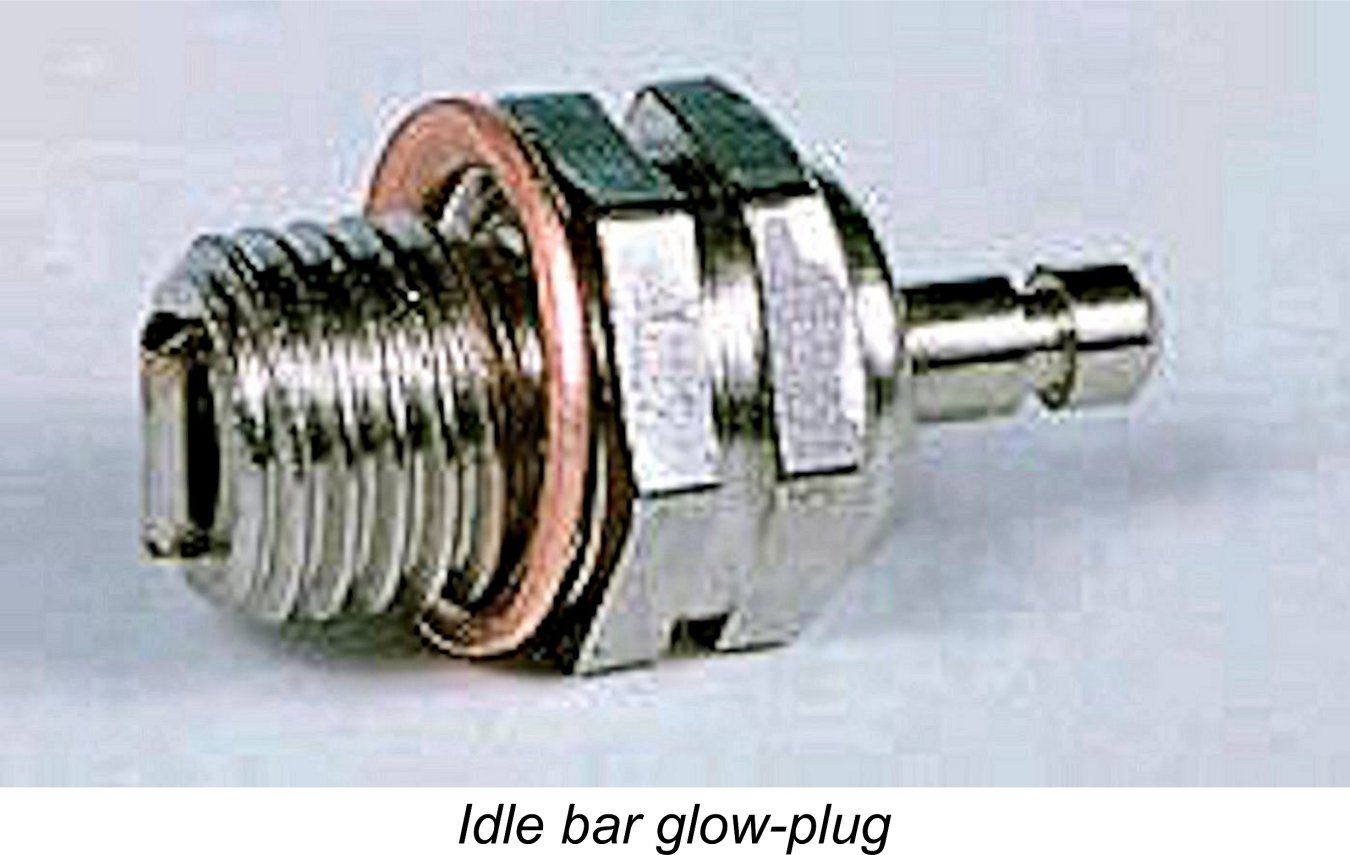 If you're selecting a plug for an R/C motor, a final complication is the decision whether or not to use an idle bar plug. If you experience a problem with the engine choking out when you crack open the throttle from idle, you may want to try a glow plug with an idle bar. An understanding of the function of the idle bar may be very helpful when making this decision.
If you're selecting a plug for an R/C motor, a final complication is the decision whether or not to use an idle bar plug. If you experience a problem with the engine choking out when you crack open the throttle from idle, you may want to try a glow plug with an idle bar. An understanding of the function of the idle bar may be very helpful when making this decision.